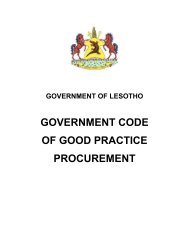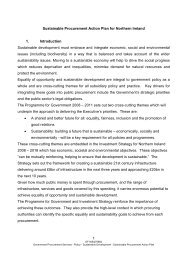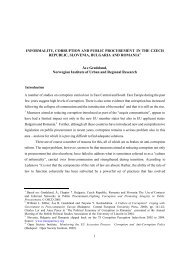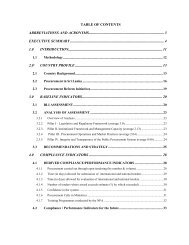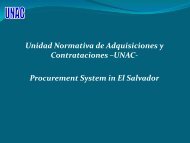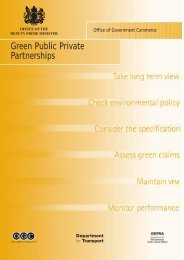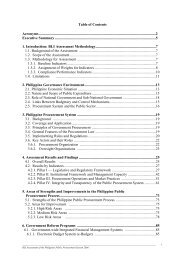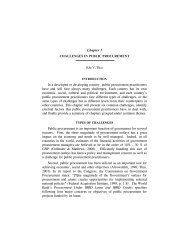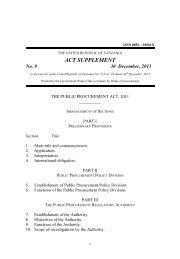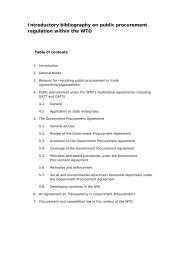Compendium of Country Examples and Lessons Learned from ...
Compendium of Country Examples and Lessons Learned from ...
Compendium of Country Examples and Lessons Learned from ...
You also want an ePaper? Increase the reach of your titles
YUMPU automatically turns print PDFs into web optimized ePapers that Google loves.
Box 12. Procurement <strong>and</strong> Public Financial Management 301. Obstacles to integration <strong>of</strong> procurement in public financial management systemsa. The problem <strong>of</strong> “voice”: Many procurement systems are characterized by staff working in the area nothaving a “voice”. Few dedicated procurement <strong>of</strong>ficers exist. Public <strong>of</strong>ficials <strong>and</strong> civil servants working inprocurement are <strong>of</strong>ten not well placed to take part in policy dialogues due to their position withinorganisational frameworks at country level. At the same time, the field <strong>of</strong> procurement is strugglingagainst misconceptions <strong>and</strong> lack <strong>of</strong> awareness, which <strong>of</strong>ten cause procurement functions to beoverlooked or assigned a low priority. The Round Table Session considers the problem <strong>of</strong> voice a mainobstacle to integration <strong>of</strong> procurement in public financial management.b. Dissonance in reform efforts: Public administration reform efforts are in many cases characterized bydissonance due to the fact that different reform areas have different stakeholders <strong>and</strong> agendas, <strong>and</strong>move at different speeds. A co-ordinated reform agenda <strong>and</strong> synchronized reform efforts in the field <strong>of</strong>procurement <strong>and</strong> public financial management is required to integrate systems.2. Entry points <strong>from</strong> which to deal with obstaclesa. The budget planning/procurement planning processb. The budget preparation/procurement planning process (revision)c. The budget execution/procurement implementation processd. The budget execution review/procurement review process (control <strong>and</strong> audit)3. Key drivers for changeThe Round Table session identified a number <strong>of</strong> factors, which may serve as useful drivers for change whenseeking to integrate procurement in the broader public financial management framework. The identified driversinclude:a. Technology: Increase the use <strong>of</strong> technology such as Integrated Financial Management InformationSystem (IFMIS), which <strong>of</strong>fers opportunities for electronic interface <strong>of</strong> procurement <strong>and</strong> public financialmanagement systems, may serve as key drivers towards ensuring communication between the twosystems, while at the same time solving the potential issue <strong>of</strong> delegation. At the same time, suchsystems should not overlook the fact that technological solutions must be based on institutional systems<strong>and</strong> sound practices in order not to risk embedding bad practices in new systems. E-procurement <strong>of</strong>fersanother technological solution, which may assist integration, e.g. through e-contract management,electronic payment functions, etc.b. Training <strong>of</strong> senior staff: Upgrade procurement skills <strong>and</strong> competencies, particularly among senior-levelstaff, is necessary in order to obtain the support for change. Training needs to be continuous <strong>and</strong>sustainable.c. High-level stakeholder involvement: Involve high-level decision makers in the change process would leadto another key driver, as high-level involvement will provide the process with a “voice” that is likely totrickle down <strong>and</strong> generate lower lever support for integration processes.d. Use <strong>of</strong> available assessment tools: The tools available in the field <strong>of</strong> procurement <strong>and</strong> public financialmanagement, including the PEFA tool <strong>and</strong> the OECD-DAC procurement assessment Methodology, alsoserve as important drivers as they motivate key stakeholders in both procurement <strong>and</strong> public financialmanagement structures to further improve their systems in accordance with the best practices/indicatorsprovided by the tools. Further integration <strong>of</strong> the two tools is needed, however, if they are to fully act asdrivers towards integration.e. Marketing/communication <strong>of</strong> the value created by sound <strong>and</strong> well integrated procurement systems, e.g.through focus on successes.The OECD Public Governance Committee: Integrity <strong>and</strong> Transparency has developed a Methodologyfollowed by the OECD in mapping good practices for integrity in public procurement including nonmembercountries such as Brazil, Chile <strong>and</strong> South Africa. The study has produced severalrecommendations:30JV on Procurement, Copenhagen, Round Table discussion on Procurement <strong>and</strong> PFM.56 COMPENDIUM OF COUNTRYEXAMPLES AND LESSONS LEARNED […] - © OECD 2008



